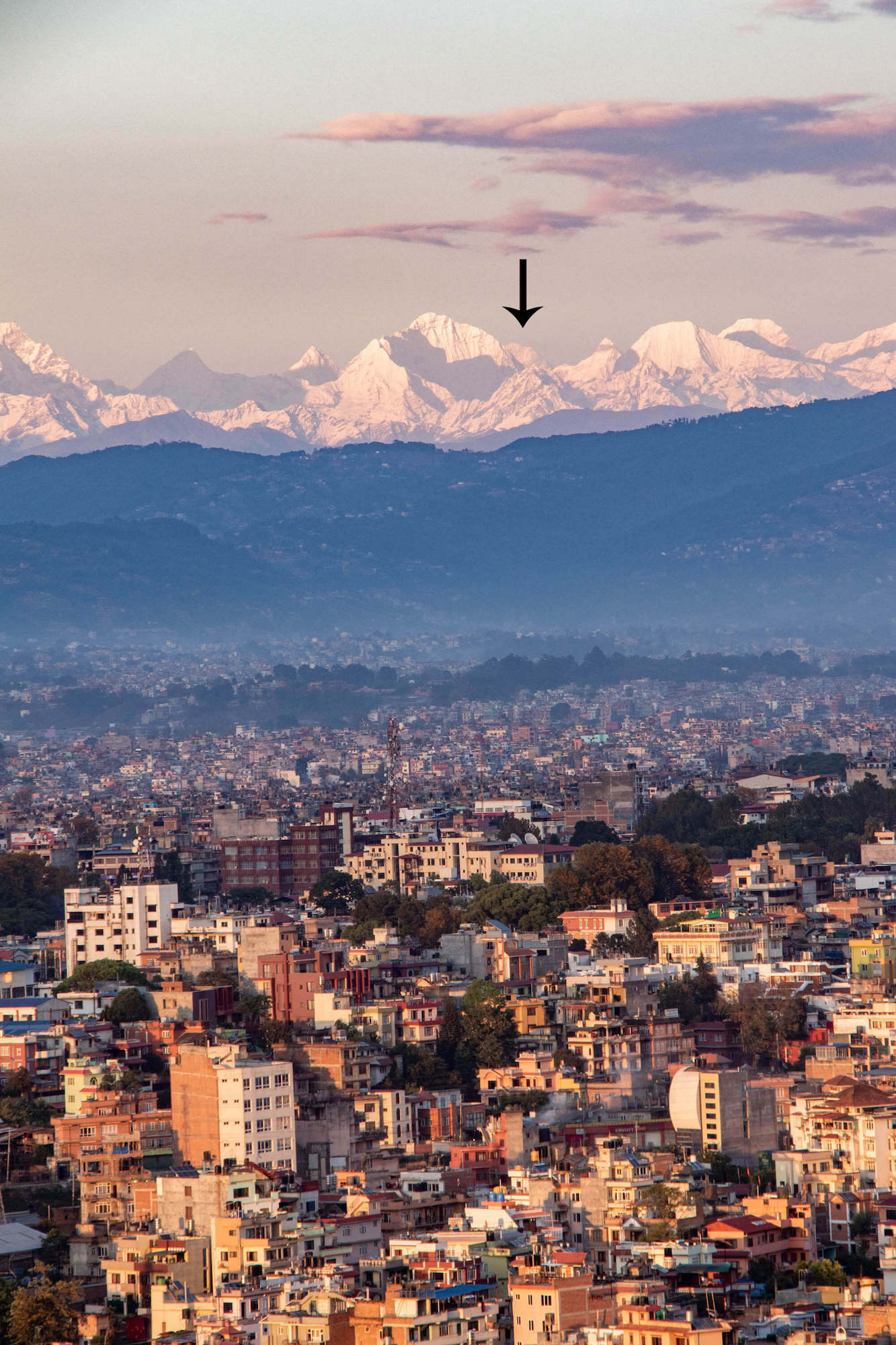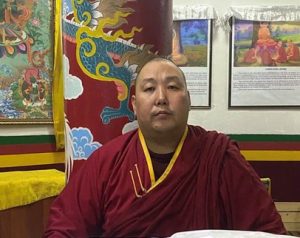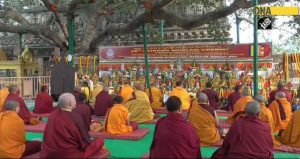
Mount Everest, some 200 kilometers distant. Photo by Abhushan Gautam. From nepalitimes.com
For the first time in decades—half a century, by some estimates—the ever-present veil of smog that envelops Nepal’s Kathmandu Valley has lifted, in the wake of a nationwide lockdown for the global COVID-19 pandemic, revealing the distant peak of Mount Everest. For many local residents, it’s the first time in their lives that the mighty peak has been visible from the Kathmandu Valley.
With the normally chaotic streets of Kathmandu peaceful and factories shuttered, Nepali photographer Abhushan Gautam was able to photograph the highest mountain in the world from some 200 kilometers away on 10 May, as the mighty Himalayan peak, known in Nepal as Sagarmatha, and as Chomolungma in the Tibetan language, basked in the evening sunlight, peaking modestly from behind Mount Kang Nachugo and Mount Chobutse.
Gautam said he had not expected to capture Everest when he went out with his camera. “I was actually looking forward to some beautiful pictures. It was raining the day before and on the same day, so the sky was clear,” he said. “I had no intentions of taking pictures of Everest and I was, in fact, capturing a panorama. Slowly I noticed the mountain, zoomed in a bit and eventually it was confirmed that the mountain was Everest.” (RepublicWorld.com)
Widespread lockdowns amid the spread of COVID-19 have immobilized millions of people across the planet, threatening economies and livelihoods in the process. Yet the abrupt suspension of economic activity has also had another telling effect of easing the burden of human pollution on the natural environment—at least temporarily. Dust, industrial pollution, and vehicle emissions are at an all-time low in many regions and cities across the globe, with skylines, waterways, and other natural features becoming cleaner with each passing day. Nature is attempting to heal herself, some people say.
“The COVID-19 lockdown has cleaned the air over Nepal and northern India. So much so that for the first time in many years, Mt. Everest can be seen again from [the] Kathmandu Valley even though it is 200 kilometers away,” the Nepali Times newspaper exclaimed in a social media post. (Twitter)
The #COVID19Lockdown has cleaned the air over #Nepal and northern #India. So much so that for the first time in many years, Mt #Everest can be seen again from #Kathmandu Valley even though it is 200km away.
— Nepali Times (@NepaliTimes) May 15, 2020
More breathtaking images by @AbhushanGautam: https://t.co/IqFZw39haC pic.twitter.com/ErTJa7kPJo
Nepal imposed its own strict nationwide lockdown and social distancing measures on 24 March. The government moved on Sunday to extend the pandemic-related restrictions by a further 15 days to end on 2 June. Ground and air transport have been suspended, and many shops and industries have been shuttered, aside from essential sectors related to food, medical items, and construction. According to reports, the air quality index in April alone improved by 33 per cent in Nepal due to a reduction in airborne particles.
So marked is the difference in air quality, that the Nepali Times noted: “Hospitals in [the] Kathmandu Valley are usually crowded this time of the year with patients suffering respiratory illnesses aggravated by pollution and dust, but in the past two months hospitals have registered a sharp drop in people seeking treatment for chronic obstructive pulmonary disease (COPD), asthma, chronic bronchitis, and allergies.” (Nepali Times)
“What we are experiencing during the lockdown is just a short reprieve it only went to prove that we can clean up Kathmandu if we want,” said climate change expert Manjeet Dhakal. “But for long-term results we need to push cleaner energy options in road transport and the COVID-19 has provided us the perfect opportunity to electrify transportation and revive our economy.” (Nepali Times)
As in so many communities and countries around the world, the coronavirus pandemic has brought with it serious social and economic challenges. It remains to be seen whether governments will learn from this global crisis and seek to take the opportunity to rebuild and restructure in more economically and environmentally sustainable directions, or whether they will cave in to the pressure to chase short-term gain, in a rush to return to business-as-usual to revive traditional economic growth.
“[The] COVID-19 pandemic has proven the benefits of reducing fossil fuel consumption on public health and the national economy,” stated the Nepali Times. “What are we going to do to maintain it?”
At the time of writing on 20 May, global SARS-CoV-2 coronavirus infections were reported to total 4.9 million, with 323,341 deaths so far confirmed, and 1.7 million people recovered.* The World Health Organization in March estimated the mortality rate from the virus at 3.4 per cent, based on incomplete and preliminary data, with the elderly and people with underlying health conditions considered most at risk. Nepal has to date reported 402 confirmed infections, with two deaths and 37 recovered.
See more
Nepal lockdown proves air quality can be improved (Nepali Times)
Breathtaking photos of Mt Everest seen from Kathmandu valley go viral (The Indian Express)
Mount Everest Visible From Kathmandu For The First Time In Decades (RepublicWorld.com)
‘Nothing like this in recent times’: Photo of Mt Everest goes viral (NZHerald.com)












